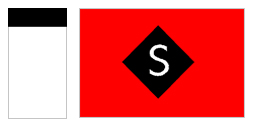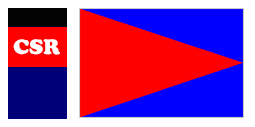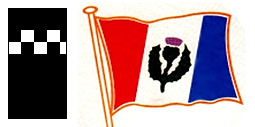Howard Smith Limited
 “Howard Smith’s” incorporation in Melbourne in 1883 followed some thirty years of steadily increasing involvement in the Australian coastal trade. It gathered under one company banner sixteen steamships and one sailing ship. In 1914, Howard Smith Limited became the parent company of an entity which had coalesced from a variety of smaller shipping interests, Australian Steamships Limited. The Great War saw its vessel Canberra trooping between Australia, the Mediterranean and the Far East. Two of its ships were casualties: the Era was sunk in the Mediterranean in May 1918 and the Clyde survived bombing in 1916.
“Howard Smith’s” incorporation in Melbourne in 1883 followed some thirty years of steadily increasing involvement in the Australian coastal trade. It gathered under one company banner sixteen steamships and one sailing ship. In 1914, Howard Smith Limited became the parent company of an entity which had coalesced from a variety of smaller shipping interests, Australian Steamships Limited. The Great War saw its vessel Canberra trooping between Australia, the Mediterranean and the Far East. Two of its ships were casualties: the Era was sunk in the Mediterranean in May 1918 and the Clyde survived bombing in 1916.
At the outbreak of the Second World War, the fleet numbered eighteen:
Ship |
Built |
Gross Tons |
In Service |
| Period | 1907 | 2791 | 1907-1946 |
| Burwah | 1908 | 2273 | 1908-1947 |
| Aeon | 1913 | 3763 | 1913-1955 |
| Canberra | 1913 | 7710 | 1913-1947 |
| Time | 1913 | 3322 | 1913-1949 |
| Innisfail | 1912 | 399 | 1916-1946 |
| Macedon | 1916 | 4368 | 1916-1955 |
| Kowarra | 1916 | 2125 | 1919-1943 |
| Kintore | 1903 | 231 | 1919-1943 |
| Era | 1921 | 3148 | 1921-1955 |
| Lady Isobel | 1921 | 1408 | 1926-1955 |
| Caledon | 1927 | 1083 | 1927-1956 |
| Euro | 1897 | 255 | 1930-1948 |
| Caldare | 1930 | 760 | 1930-1956 |
| Marimba | 1913 | 139 | 1932-1961 |
| Marrawah | 1910 | 472 | 1936-1947 |
| Age | 1936 | 4734 | 1937-1968 |
| Cycle | 1939 | 3952 | 1939-1961 |
Canberra again went into service, under requisition from July 1941, periodically trooping, carrying about 650 personnel. Kowarra was lost to enemy action, torpedoed by a Japanese submarine while en route Bowen-Brisbane with a cargo of sugar, on 24 April 1943, with the loss of twenty-one lives. Age, Period and Canberra, though experiencing enemy attacks and loss of crew lives, survived as did the remainder of the fleet, to resume peacetime service after 1945 (in the case of Canberra after June 1946 . Innisfail served under requisition, while also requisitioned from November 1941 Marrawah operated as a minesweeper until February 1943, then spent the remainder of the war with the United States Small Ships Section.
Read moreDate posted: 2014-04-01 | Comments(0)
Wm. Holyman & Sons Pty Limited
 This name of the Company dates from 1924, however its founder, the son of an English Master Mariner, arrived as an apprentice on the barque Elizabeth Radcliffe in Launceston, Tasmania seventy years earlier. Continuing his seafaring for some thirty years, he steadily (and through many adversities) built up his company, his fleet – initially ketches, paddle steamers and cutters - and his seafaring family. By the 1920s “Holymans” were trading to Victoria and South Australia as well as around Tasmania. Despite possessing a responsibly innovative and venturesome character, the Company’s maritime activity inevitably involved numerous ship casualties and crew losses, one claiming the life of one of the founder’s grandsons, the ship’s master. For a time the line went by the name of White Star Line. Remaining a private company, they branched post- Second World War into the airline industry (until 1957) and road transport although shipping remained central.
This name of the Company dates from 1924, however its founder, the son of an English Master Mariner, arrived as an apprentice on the barque Elizabeth Radcliffe in Launceston, Tasmania seventy years earlier. Continuing his seafaring for some thirty years, he steadily (and through many adversities) built up his company, his fleet – initially ketches, paddle steamers and cutters - and his seafaring family. By the 1920s “Holymans” were trading to Victoria and South Australia as well as around Tasmania. Despite possessing a responsibly innovative and venturesome character, the Company’s maritime activity inevitably involved numerous ship casualties and crew losses, one claiming the life of one of the founder’s grandsons, the ship’s master. For a time the line went by the name of White Star Line. Remaining a private company, they branched post- Second World War into the airline industry (until 1957) and road transport although shipping remained central.
When the Second World War started Holyman had ten ships:
Ship |
Built |
Gross Tons |
In Service |
| Mongana | 1908 | ? | ? |
| Tambar | 1912 | 456 | ?-1960 |
| Wareatea | 1883 | 512 | 1904-1945 |
| Laranah | 1914 | 701 | 1914-1956 |
| Lutana | 1922 | 918 | 1924-1955 |
| Lanena | 1925 | 1018 | 1925-1956 |
| Woniora | 1913 | 823 | 1926-1959 |
| Merilyn | 1921 | 239 | 1933-1948 |
| Lorinna | 1938 | 1185 | 1938-1961 |
| Wannon | 1919 | 567 | 1939-1957 |
During the war years, Wannon was engaged in re-supply duties in the island areas of Papua New Guinea. Requisitioned were Laranah, Tambar for minesweeping, Mongana as an Examination, then stores vessel, while Lorinna came under control of the United States Small Ships Section.
Read moreDate posted: 2014-04-01 | Comments(0)
Colonial Sugar Refining Company Limited
 A major participant in the Australian and Pacific sugar industry, “C.S.R.” operated its own ships, particularly suited to the bulk sugar trade. During the Great War, Rona (the first of that name) had been requisitioned on completion of building in March 1918 and operated as HM Transport Y2205 in Mediterranean and Asian waters.
A major participant in the Australian and Pacific sugar industry, “C.S.R.” operated its own ships, particularly suited to the bulk sugar trade. During the Great War, Rona (the first of that name) had been requisitioned on completion of building in March 1918 and operated as HM Transport Y2205 in Mediterranean and Asian waters.
At the beginning of the Second World War it had two ships, with one more joining them as the war progressed:
Ship |
Built |
Gross Tons |
In Service |
| Rona | 1918 | 6205 | 1918-1956 |
| Fiona | 1933 | 3454 | 1933-1958 |
| Moamoa | 1937 | 554 | 1941-1946 |
As well, Tambua (gt.3615) was under construction in 1939.
Rona participated in the Allied armed forces' resupply program between Australia and Fiji, while the Royal Australian Navy utilised Fiona, based in Darwin, as a Stores and Water Supply ship. Moamoa (a former Burns Philp vessel, owned by C.S.R. from February 1941) was requisitioned by United States forces late in 1942 for the duration, as a supply ship for Milne Bay-based Motor Torpedo Boats. Tambua, requisitioned on building completion, was based in Colombo as a Stores and Water Supply ship for Royal Navy vessels and was handed to her owners in 1946.
Read moreDate posted: 2014-04-01 | Comments(0)
WR Carpenter & Company Limited

Ship |
Built |
Gross Tons |
In Service |
| Rabaul | 1916 | 5618 | 1934-1941 |
| Salamaua | 1920 | 6676 | 1934-1953 |
| Suva | 1938 | 4873 | 1938-1963 |
As well as these their ship, the Noorebar, though possibly having been lost in the Rabaul volcano of 1937, is thought may have fallen victim of the Japanese invasion of Rabaul early in 1942. The Rabaul sailed the world’s oceans as part of the Allied cause until while under requisition voyage in the South Atlantic she was shelled and sunk on 14 May 1941, the survivors being imprisoned in enemy hands until war’s end.
Read moreDate posted: 2014-04-01 | Comments(0)
Burns, Philp & Company Limited
 As a successor to trading activity commenced in Queensland twenty years earlier, this company (“B.P.”s) was incorporated in Sydney in 1883. It was destined to become a pioneer and ambassador for Australia in much of the South-West Pacific area as well as nationally, for more than a century a multi-national conglomerate whose ship-owning activities date from January 1896. During the Great War its Matunga, en route from Sydney to Rabaul, was captured on 6 August 1917 by the German raiding ship Wolf, which sank it, carrying its crew and passengers into captivity in Europe until war’s end.
As a successor to trading activity commenced in Queensland twenty years earlier, this company (“B.P.”s) was incorporated in Sydney in 1883. It was destined to become a pioneer and ambassador for Australia in much of the South-West Pacific area as well as nationally, for more than a century a multi-national conglomerate whose ship-owning activities date from January 1896. During the Great War its Matunga, en route from Sydney to Rabaul, was captured on 6 August 1917 by the German raiding ship Wolf, which sank it, carrying its crew and passengers into captivity in Europe until war’s end.
By 1939, Burns Philp mariners had accumulated a vast, detailed knowledge of the channels, reefs and shoals of the South West Pacific islands. This knowledge, together with their pilotage and guidance skills proved invaluable (several being decorated) as the “island-hopping” campaigns of the Allies repulsed the Japanese incursions.
As the Second World War commenced the company had, as well as many smaller inter-island vessels, ten ships in its mainline fleet:
Ship |
Built |
Gross Tons |
In Service |
| Montoro | 1912 | 4057 | 1912-1955 |
| Morinda | 1913 | 1917 | 1913-1953 |
| Marella | 1917 | 7475 | 1920-1948 |
| Mangola | 1920 | 3350 | 1925-1957 |
| Macdhui | 1930 | 4561 | 1931-1942 |
| Malaita | 1933 | 3310 | 1933-1965 |
| Neptuna | 1924 | 5952 | 1935-1942 |
| Merkur | 1924 | 5952 | 1935-1953 |
| Bulolo | 1938 | 6267 | 1938-1968 |
| Tulagi | 1939 | 2281 | 1939-1944 |
As well, Burnside (b.1940.gt. 5659. s.1940-1964) was under construction in the United Kingdom, while the inter-island Muliama (b.1937, gt.689, s.1937-1957) was drawn into Australian service. Burnside was returned to the company by the British Ministry of War Transport in 1946.
Bulolo was requisitioned 22 September 1939 for Royal Navy war service as an Armed Merchant Cruiser, Burnside on completion was taken over by the British Ministry of War Transport and Merkur was taken over by the Royal Australian Navy on 12 December 1941 as a Victualling Stores Issue Ship, serving in this role until June 1948. Montoro had significant involvement in trooping duties between southern Australian ports, the country’s north and Papua New Guinea. Neptuna was bombed and sunk in Darwin on 19 February 1942 with forty-five killed, Macdhui was bombed and sunk in Port Moresby on 18 June 1942 with ten killed, Malaita, taken over by the Royal Australian Navy in March 1942, was torpedoed by Japanese submarine RO.33 off Port Moresby harbour on 29 August 1942 and Tulagi was sunk in the Indian Ocean on 27 March 1944 with the loss of forty-seven lives.
Notable among the numerous inter-island vessels lost, three of the larger ones, Lakatoi, Matafele and Mamutu fell victim to enemy action: Lakatoi , (b.1938 gt.341 svce.1938-1943) was presumed sunk, with the loss of twenty-three personnel, Matafele (b.1938 gt.355 svce.1938-1942), requisitioned by the Royal Australian Navy in 1943, was presumed sunk, the cause unknown, between Townsville and Milne Bay, its total loss including seventeen crew and twenty naval ratings, and Mamutu (b.1938 gt.300 svce.1938-1942) was sunk by submarine RO33 in the Torres Strait, with twenty-three crew and 119 passengers killed, one person surviving.
Read moreDate posted: 2014-04-01 | Comments(0)